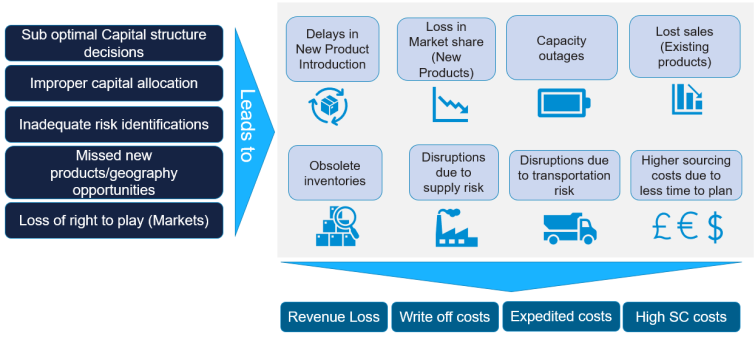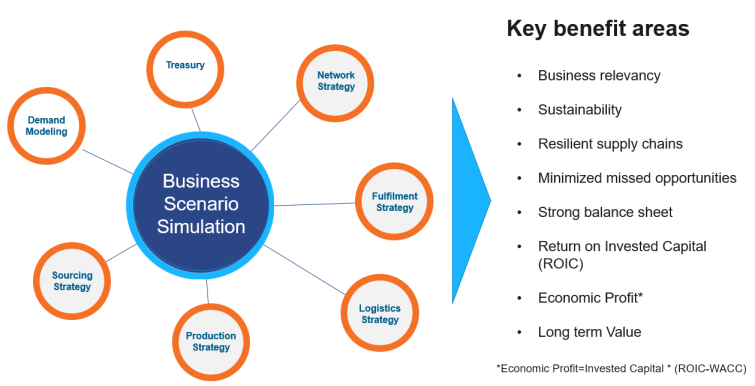Holistic Strategic Planning that Creates Long-Term Value: A joint role for Supply Chain, Finance, and S&OP

Is your organization fully equipped to understand and meet customer expectations for the long term?
In an ever-changing business environment rife with inflation, rising interest rates, and recession uncertainties, the temptation might be to continue with short-term, inward-looking planning processes. After all, no one can predict the future, right?
At best, a short-term focused practice — one that looks up to three months in advance — may yield short-term results, but those results are purely by chance. By definition, these results may not be repeatable. Organizations that adopt a supply-driven approach miss vital opportunities to create long-lasting impacts when they do not prepare for longer horizons.
A few of these challenges and the resulting areas of impact are outlined in the diagram below:

While no one can predict the future, companies that understand risk exposures and can navigate volatile and uncertain business environments deftly and continuously are the kind that can weather the storm and even come out stronger on the other side.
Strategic decision-making builds relevance and resilience. It also requires long-term planning, long-term investments, and aligning the business with forthcoming trends. In other words, creating long-term value necessitates thinking about long-term business designs, in contrast to short and internally-focused plans.
Sales and operations planning and finance must unite
To become sector leaders, sales and operations planning organizations must plan (much in advance) to align their supply chain footprints in response to the anticipated changes in the business environment. For example, changes in capacity augmentation decisions in the mining industry, or drug research in the case of the pharmaceutical industry need a much longer-term view that can help in planning their operations.
Finance and strategy teams need a reliable and holistic approach to build futuristic — and realistic — business scenarios and address fundamental themes. The first step towards developing such an integrated practice starts with gaining a better understanding of markets, customers, technology, and outside influences on the business. Transitioning to integrated strategic management requires a seamless contribution from cross-functional teams within the organization. Solutions that ingest a wide variety of data or information to assess the market and translate these data into various response options and scenarios become handy for the teams.
Companies need a solution that renders external insights to strengthen organizational strategic planning and support supply chain design.
Important questions for an integrated, long-term planning process
An integrated strategic management process helps organizations answer key business questions, such as:
- What happens if the economy goes into recession or expansion?
- What is the long-term demand for products and services?
- What are the supply chain risks?
- Will the business need to raise long-term capital?
- What should the fulfillment strategy be?
- What are potential channels for distribution?
- How much capital is needed over the next 10 years?
- How will customer buying behavior change in the long term?
- Are there immediate needs for short-term liquidity?
- Is there a need to reallocate capital investments?
How Coupa supports long-term strategic planning
Coupa’s solution portfolio contains the essential ingredients that can support the organization’s strategic planning and value-creation pursuits. The key solution component characteristics are outlined below:
- Demand Modeler incorporates external data to better understand causal factors and test demand scenarios. The solution contains over 280,000 time series across all countries and WorldBank data for major categories. It:
- Helps organizations assess future customer and market characteristics
- Generates insights into product life cycle management in line with demographic changes
- Supply Chain Modeler ingests various demand scenarios and supports organizations in building various supply chain designs catering to specific strategic objectives. It:
- Helps organizations outline probable supply chain risks and evaluate risk mitigating scenarios
- Supports the organization in understanding the impact on channel mix changes and guides subsequent planning for the future
- Is able to continuously design fulfillment strategies and align with the organization’s sustainability targets Guides the organization on the process of balancing multiple dimensions of the business, namely- cost, profitability, resilience, and service levels
- Treasury takes in the business scenarios and the response options and appropriately guides the organizations in financial management. It:
- Helps effectively translate supply chain responses into liquidity plans
- Visualizes the capital needs and defines the optimal mix of capital sources for longer horizons
- Provides comprehensive visibility of cash flows at an organizational level that can help optimize capital allocation in a way that is aligned with long term value generation
Coupa’s solution portfolio enables CFOs to stress test multiple business scenarios with reasonable ease and accuracy. The interaction among various solution components and the areas of benefits are summarized below:

Comprehensive scenario simulation is essential for long-term strategic planning. Companies seeking to move beyond short-term, ad-hoc business decisions should embrace a technology platform that improves data-sharing, communication, and planning between all of the business functions identified above. Especially when finance, procurement, and supply chain work as a coordinated set of units, companies save money, gain value, and outperform their competitors.
Download the Free eBook
